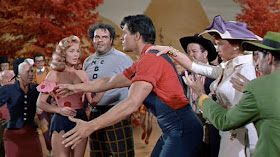...the Top Ten of 1959! In alphabetical order! After the jump....
dir/pr: Otto Preminger
scr: Wendell Mayes
cin: Sam Leavitt
cin: Sam Leavitt
Just damn good grown-up entertainment. Click here for previous discussions.
dir: Marcel Camus
scr: Marcel Camus / Jacques Viot
pr: Sacha Gordine
pr: Sacha Gordine
cin: Jean Bourgoin
Taking place on the eve before and night of Rio's Carnaval celebration, the colors and textures dazzle, lit by golden sunlight, pale streetlamps, burning emergency lights, and smoky cigars. The cacophany of music and celebration rarely recedes; there is never a sense of solitude. And yet. Two people - a woman escaping violence, a man escaping responsibility even as he shruggingly signs up for it - see each other, sing together, connect as one. Melancholy and colorful, tragic and hopeful, an infectious and haunting experience.
dir/scr/pr: Samuel Fuller
cin: Sam Leavitt
Opens with burlesque and a bullet, before taking to the streets of LA's Little Tokyo. It enriches its noir mystery with a love triangle complicated by brotherhood and the issue of race and the American Identity. Colorful characters abound, led by an agonizing, sexy performance by James Shigeta, and culminating in a final chase and shoot-out that allows for one of the most haunting, heartbreaking confession scenes I've ever seen in a movie. Painfully aware of everyone's humanity, this movie.
dir/pr: William Castle
scr: Robb White
cin: Carl E. Guthrie
The showcase for two of the greats: William Castle and Vincent Price. For Castle, it's not just the gimmick of "Emergo", complete with dancing skeleton (it pales in comparison to his gimmicks for The Tingler the same year - buzzing theater seats and a shocking colorized sequence), but his ability to assemble scares, laughs, a logical explanation for 3/4 of the film's events and a supernatural one the rest of it into a damn good 90 minutes. For Price, it's the perfect role: campy, sinister, totally unheroic yet not quite villainous - charm with a side of menace, or vice versa - his greatest gifts given their greatest outlet.

The Human Condition: No Greater Love
dir: Masaki Kobayashi
scr: Zenzô Matsuyama & Masaki Kobayashi
pr: Shigeru Wakatsuki
cin: Yoshio Miyajima
The first volume of Masaki Kobayashi's adaptation of the six-volume epic by Junpei Gomikawa, a three-and-a-half-hour epic in which a humanist tries to impart his philosophy through his work as a labor camp supervisor in Japanese-occupied Manchuria during World War II. I think it should be obvious that that POV does not exactly sit well with his fellow Japanese and is looked on with suspicion by Chinese prisoners of war left in his charge. Relentlessly grim, its depiction of our brutality is almost as agonizing as its reflection of our stubbornness. And yet, I would not call this a tough sit: the performances, production value, and story prove to be uniquely absorbing.
dir/scr/pr: Sergei Eisenstein
cin: Andrei Moskvin / Eduard Tisse
A continuation of my favorite film of 1947, both Stalin and Eisenstein had to die before the USSR would finally release it, as the director used Part Two to depict Ivan's increasing paranoia, obsession with past rivals, brutal dispatching of enemies, and yo-yo alliances. This is still, of course, built within a narrative of a man attempting to liberate Russia from foreign interests and power-hungry elitists. A long two-color-processed party sequence is shot and edited like a traumatic memory invading your dreams. And Nikolay Cherkasov is still giving one of the most hypnotic performances captured on celluloid. Pure cinema.
dir: Melvin Frank
scr: Melvin Frank / Norman Panama
pr: Norman Panama
pr: Norman Panama
cin: Daniel L. Fapp
What a rude movie! There is no human being out there that the Li'l Abner universe does not downright despise, taking aim beyond "acceptable" targets like politicians at the armed forces, scientists, and the American people, with our simultaneous fetishization and dismissal of the poor, our mythologizing of shady historical events, and our pride at our refusal to adapt. What a demented, hilarious, fever dream of a film!
dir: Fred Zinnemann
scr: Robert Anderson
pr: Henry Blanke
pr: Henry Blanke
cin: Franz Planer
Enriching for the soul. Click here for previous discussions.

Sapphire
dir: Basil Dearden
scr: Janet Green, additional dialogue by Lukas Heller
pr: Michael Relph
cin: Harry Waxman
I love a mystery, I do, and Sapphire's is an especially twisty one: the brutal murder of a girl who, though believed by all who met her to be pure white, was actually mixed - and therefore, in the eyes of 1950s society, Black. An exploration of race and class and a murder puzzle? Just terrific!
dir/scr/pr: Delmer Daves
cin: Harry Stradling, Sr.
Talk about the sins of the father! Famous for its instrumental teenage love theme, this melodrama is filled with enough passion and scandal for two movies. Dips into the Peyton Place well more than once, right down to the casting of Arthur Kennedy as a Bad Dad, but carves its own identity with its neatly divided focus and its ability to celebrate forgiveness, legacy, and liberation without a lot of finger-wagging. Or rape! A class act that still feels, ahem, hip.
Tomorrow - the nominees for the 1959 Hollmann Awards!













No comments:
Post a Comment